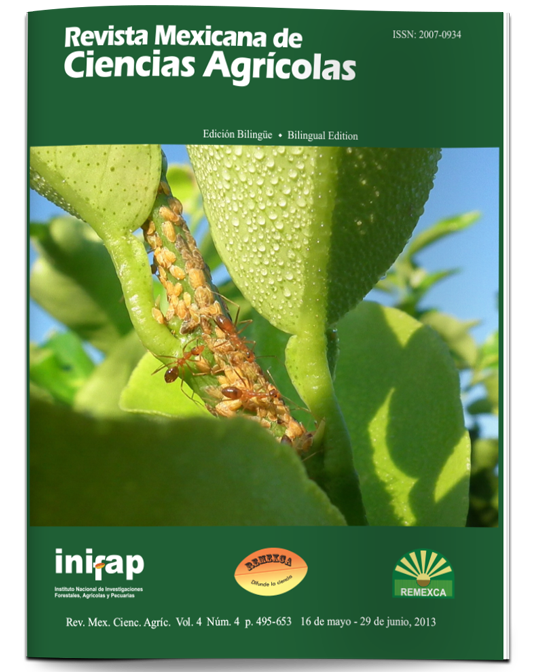Competition between isolates of Septoria tritici Rog. Ex Desm. in bread wheat (Triticum aestivum L.)
DOI:
https://doi.org/10.29312/remexca.v4i4.1195Keywords:
aggressiveness, competition, genetic variants, pycnidiaAbstract
Inoculations with different isolates are done to obtain wheat genotypes resistant to Septoria tritici; however, there is evidence of competition between the isolates that overestimates the resistance response of the genotypes. To check this, the aim of this study was to test three wheat genotypes with different levels of resistance to this fungus, which was inoculated with isolates P8, P9 and B1, individually and in mixtures. The experiment was established in 2006 under a split plot design with three replicates. Pycnidia were collected from the flag leaf and the lower leaf to identify, using RFLPs, the isolates that established and prevailed in the different genotypes. When P8, P9 and B1 were inoculated individually, the original isolate was recovered; when they were inoculated in mixture, P9 was not re-isolated, which evidenced the competition between the isolates and the low aggressiveness of P9.B1 had the highest recovery rate. With B1 and P8, genetic variants were reisolated whose presence was inf luenced by the wheat genotype and the isolates with which they were mixed. Because competition can reduce the aggressiveness and pathogenicity of the isolates inoculated in mixture, the best strategy in wheat breeding programs to select resistance is to inoculate the isolates individually.
Downloads
Downloads
Published
How to Cite
Issue
Section
License
The authors who publish in Revista Mexicana de Ciencias Agrícolas accept the following conditions:
In accordance with copyright laws, Revista Mexicana de Ciencias Agrícolas recognizes and respects the authors’ moral right and ownership of property rights which will be transferred to the journal for dissemination in open access. Invariably, all the authors have to sign a letter of transfer of property rights and of originality of the article to Instituto Nacional de Investigaciones Forestales, Agrícolas y Pecuarias (INIFAP) [National Institute of Forestry, Agricultural and Livestock Research]. The author(s) must pay a fee for the reception of articles before proceeding to editorial review.
All the texts published by Revista Mexicana de Ciencias Agrícolas —with no exception— are distributed under a Creative Commons License Attribution-NonCommercial 4.0 International (CC BY-NC 4.0), which allows third parties to use the publication as long as the work’s authorship and its first publication in this journal are mentioned.
The author(s) can enter into independent and additional contractual agreements for the nonexclusive distribution of the version of the article published in Revista Mexicana de Ciencias Agrícolas (for example include it into an institutional repository or publish it in a book) as long as it is clearly and explicitly indicated that the work was published for the first time in Revista Mexicana de Ciencias Agrícolas.
For all the above, the authors shall send the Letter-transfer of Property Rights for the first publication duly filled in and signed by the author(s). This form must be sent as a PDF file to: revista_atm@yahoo.com.mx; cienciasagricola@inifap.gob.mx; remexca2017@gmail.
This work is licensed under a Creative Commons Attribution-Noncommercial 4.0 International license.



